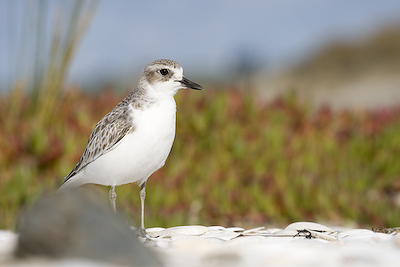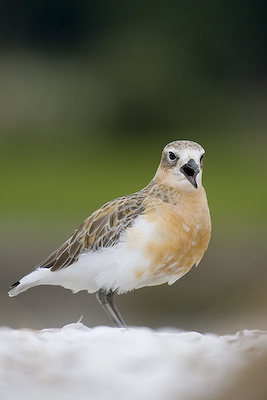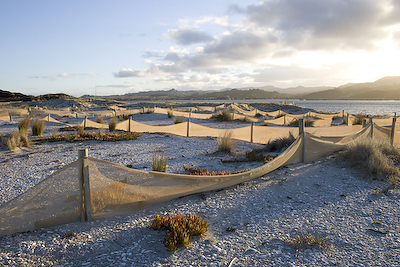Life’s a beach…
As I come to the end of nearly two thoroughly enjoyable years observing New Zealand’s wildlife through my camera, I have become aware of many startling differences between my experiences of nature in Aotearoa and my home in the UK, and how these differences affect our perception of the natural world and the future for our wildlife.

The endangered NZ Dotteral, Photo: Tom Marshall
Since I flew in over the Southern Alps in late 2007, I have relished the chance to genuinely explore and discover New Zealand’s wildlife in a way rarely possible in the UK – by simply visiting the local shoreline, taking a tramp in the high country or by getting eye-to-eye with wading birds in the mud of Te Waihora Lake Ellesmere.
It is this truly liberating opportunity to be at one with wildlife that is totally enthralling when you have spent past experiences viewing the most sought-after British species from a glass-fronted visitor centre, ‘hide’ or behind a conservation area fenceline. But whilst the highly organised wildlife and conservation industry in Europe and America could be accused of turning wildlife into just another tourist ‘tick-off’ – a Scottish osprey live on camera here, or a peregrine falcon nesting atop a London skyscraper there, there is one common theme across all these sites – protection.
As a nature photographer, it is quite exceptional to be able to don your camouflage gear and go in search of a New Zealand Dotterel, Black-fronted Tern or Tawaki and be able to capture them at their most stunning amongst the sea-strewn shells and sand dunes. To get close to these species requires patience, sore elbows and in the case of the pioneering Geoff Moon, many hours in a hide – but all the time ensuring the birds barely know you are there. However, this unparalleled opportunity to capture inspiring images of New Zealand’s wildlife is only possible due to the large areas of open access afforded to most habitats in New Zealand.
But what then happens when a car full of local boy-racers decide to drop in for a few beers and some wheel-spins – in the middle of a breeding colony of dotterel of wrybills?

NZ Dotteral, Photo: Tom Marshall
On far too many occasions I’ve taken the time to silently approach a group of shorebirds only to have them sent scattering by an excitable un-leashed dog, or worse still, photographing a nesting Wrybill only to return 24 hours later to see a motorcycle track where a couple of pebbly eggs once rested. There are even cases of dogs attacking and killing some of our rarest penguins whilst out on their evening walk.
So where does this leave the wildlife? Well, in many cases, in rather a lot of trouble as our leisure time finds us wanting to use the beaches and other habitats that we also have to share with some of our rarest species. With such a beautiful country to enjoy, it is not surprising that we all want a slice of the outdoors, but at what cost?
It would no doubt be inappropriate to compare the conservation nature reserve networks of Europe (with their financial and membership support) to New Zealand, but perhaps we should ask ourselves if a string fence and polite sign is enough to protect a species with less than a dozen breeding pairs?
Whilst New Zealand no doubt often lacks the resources and financial clout of conservation groups overseas, we surely cannot simply raise our hands in defeat and allow species to dwindle to the brink, simply for the sake of having mile after mile of beach or estuary at our recreational disposal, when securing a fraction of this area for native wildlife is often all that is needed?
But with any protection must come information, passion and enthusiasm – people need to understand why they are being asked to sacrifice their beach, and raising the profile of these species through engaging with the public both face-to-face and through the media is crucial to build local and national ‘ownership’ of rare wildlife, so trampling a dotterel nest becomes unacceptable not only to us ‘tree-hugging greenies’ but to everyone in the local community too.

Fenced off nesting areas. Photo: Tom Marshall
Such local support can pay dividends as recently found at Te Arai Beach near Auckland where local community support has led to a reprieve for breeding areas for fairy terns and NZ dotterel, where a beach-front home and resort project may otherwise have been built. Although court proceedings may yet come, for now it seems, native wildlife has taken a rare priority over profits and a sought-after sea view.
New Zealand wildlife plays an integral part in Kiwi life – perhaps more than most countries, from the daily advertisements that hit our TV screens, to the beers we drink and even the national identity. In many cases the advantages of taking a rare species under the wing of the community can not only have conservation benefits, but financial ones too, as many nature-based tourism areas in New Zealand will testify.
With such regular development challenges and at a time when mainstream economies are at the greatest strain, perhaps the government should not be reducing the budgets of organisations like the Department of Conservation, but instead increasing its ability to protect and enhance New Zealand’s natural world – for the thousands of overseas tourists who visit each year to enjoy it. High Street spending will come and go, but if you lose a species there can be no government bail-out, no boom-and-bust – extinction is final.
So in a few weeks time when I find myself in a wooden shed overlooking a drizzly British wetland, I’ll no doubt be wishing I was back amongst the Aotearoa mud, coming face-to-face with a wrybill or fairy tern, but safe in the knowledge that they will always be there for everyone to enjoy.
